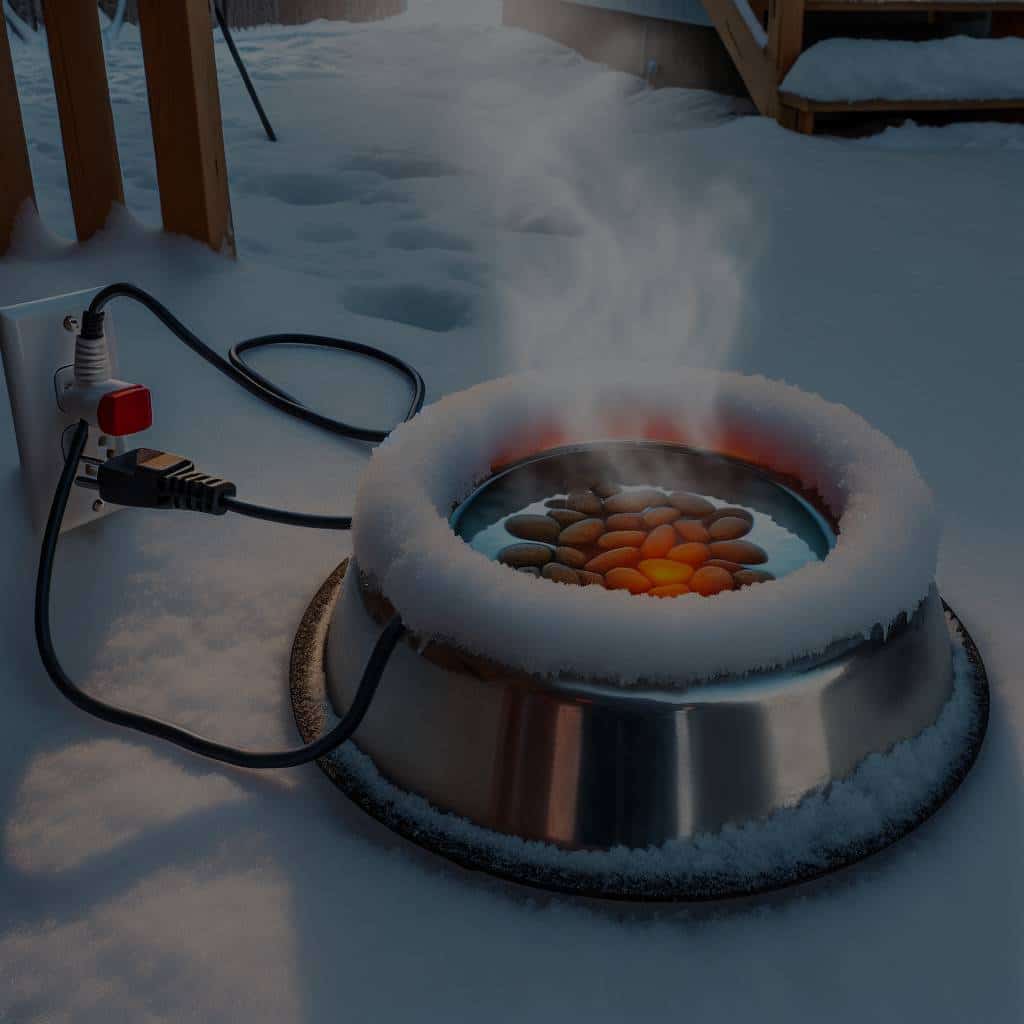What’s the Best Way to Keep a Pet’s Water Bowl from Freezing Outdoors?

In the depths of winter, when icy winds howl and snow blankets the ground, ensuring our pets have access to unfrozen water can become a challenging task. Dogs, cats, and other outdoor pets rely heavily on their bowls of water to stay hydrated and healthy during the colder days. The cold doesn’t just bring discomfort to our pets; it risks their hydration levels by freezing their water sources. This article will delve into some of the best methods to prevent your pets’ water bowls from freezing outdoors and ensure your beloved animal companions always have access to the warm, drinkable water they need.
Heated Bowls
A heated pet bowl is a simple and effective solution for preventing freezing. Made with a built-in heating element, these bowls maintain a steady water temperature, preventing ice formation even during the harshest winter days.
En parallèle : How to Correctly Measure Your Horse for a Custom Fitted Saddle?
Heated bowls come in a variety of shapes, sizes, and designs, catering to different pet needs. Some models feature thermostatic control, which can cut off the heat when the water reaches a certain temperature. This feature not only conserves energy but also keeps the water at a comfortable temperature for your pet.
While a heated bowl may seem like an obvious solution, there are some considerations to keep in mind. You will need an electrical source to power the bowl, which may not always be conveniently located near your pet’s outdoor area. Also, regular cleaning is crucial to prevent bacteria build-up in the bowl.
Cela peut vous intéresser : What’s the Best Way to Enhance Mental Stimulation for Indoor Pets?
Insulation Techniques
When electricity is not an option, or when you prefer a more natural solution, insulating your pet’s water bowl can be a smart move. Insulation traps heat and prevents the cold from reaching the water, thus keeping it from freezing.
A simple and cost-effective way to insulate your pet’s water bowl is by placing it inside a larger bowl filled with insulation material. You might use straw, foam, or even old fabrics or clothes. The insulation material creates a barrier between the cold outside air and the water bowl, helping to keep the water warm.
Another method involves burying the bowl partly in the ground, using the earth’s natural insulation to protect the water from freezing. For this method, ensure the bowl is still easily accessible to your pet and doesn’t get filled with dirt or debris.
Using Warm Rocks
Warm rocks can be an alternative heat source for your pet’s water bowl. During the day, rocks can absorb heat from the sun, which they then slowly release. This stored heat can keep your pet’s water from freezing, at least for a while.
To use this method, simply place a few rocks in a sunny location during the day. In the evening, put the heated rocks into your pet’s water bowl. Make sure the rocks are not hot enough to harm your pet and are large enough not to be a choking hazard.
This method requires more effort, as you need to replace the rocks every day or even more frequently during particularly cold days. However, it can be a valuable short-term solution when other methods are not feasible.
Regular Water Change
Sometimes, the simplest method might be the best. Regularly changing your pet’s water can be an effective way to prevent freezing.
It’s especially helpful if your pet spends only certain hours outdoors. Just before letting your pet out, fill the bowl with warm (not hot) water. This water will take a while to cool down and freeze, giving your pet ample time to drink.
Regular water changes also have the added benefit of ensuring your pet has fresh, clean water at all times. However, this method can be time-consuming and might not be suitable if your pet spends the whole day outdoors.
Using Salt or Sugar
Salt and sugar both lower the freezing point of water, which means adding some to your pet’s water bowl can prevent it from freezing as quickly. However, it’s important to note that these substances should be used sparingly, as excessive salt or sugar can harm your pet’s health.
Before you add any salt or sugar to your pet’s water, consult with your vet. They can advise you on safe amounts and whether this method is suitable for your specific pet.
In conclusion, there is no one-size-fits-all solution to keep your pet’s water bowl from freezing outdoors. The best method depends on your specific circumstances, including your pet’s habits, your local climate, and available resources. But with these tips in mind, you can ensure your pet always has access to the liquid life source they need, even on the coldest winter days.
Using a Thermal Blanket or Heated Mat
Thermal blankets or heated mats are another alternative to keep your pet’s water bowl from freezing during severe winter months. These devices use minimal electricity and distribute heat evenly, preventing the water from turning to ice.
You can place a thermal blanket or heated mat underneath your pet’s water bowl. These devices generate and maintain warm temperatures, which help keep the water in your pet’s bowl in a liquid state. They are especially ideal for pets that stay outdoors for extended periods, or for those residing in particularly cold regions.
There are several types of thermal blankets and heated mats available in the market, each varying in size, price, and heating capability. Some even come with temperature control settings, allowing you to adjust the heat according to the requirement. Always remember to switch off the blanket or mat when not in use to prevent overheating and save electricity.
Keep in mind, however, that thermal blankets and heated mats should be used with caution. Ensure that they are properly insulated and that your pet cannot chew or damage the electrical wiring. It’s also essential that the blanket or mat is dry at all times to prevent the risk of electrical shock. A waterproof bowl would be a preferred choice when using this method.
Enclosure or Shelter for the Water Bowl
Creating an enclosure or shelter for your pet’s water bowl is another practical solution to prevent the water from freezing. This method essentially involves protecting the water bowl from the cold outdoor environment, which can substantially delay the freezing process.
An enclosure can be as simple as a makeshift tent or a box positioned over the water bowl. The idea is to shield the water bowl from freezing temperatures by reducing its exposure to cold winds and snowy conditions. You can also line the interior of the shelter with insulating materials such as styrofoam or old blankets for added warmth.
Alternatively, you could place the water bowl within an insulated dog house or outdoor cat shelter if your pet has one. This way, not only will the water stay warmer for longer, but your pet will also have a cozy spot to drink comfortably.
Keep the opening of the shelter facing away from the direction of the wind for maximum protection. Also, ensure that the shelter is sturdy and secure so that it doesn’t topple over or get blown away.
Remember, while enclosures or shelters can help keep your pet’s water from freezing, they might not be enough during extreme cold weather. In such cases, you might need to combine this method with one of the others mentioned above to ensure that your pet has access to liquid water throughout the day.
Conclusion
The well-being and comfort of our pets are paramount, especially during the harsh winter months when they rely on us the most. Dehydration can pose significant risks to their health, and having a constant supply of unfrozen water is essential.
Whether you choose to use a heated bowl, insulation techniques, warm rocks, regular water changes, salt or sugar, a thermal blanket or heated mat, or an enclosure or shelter, remember that the goal is to ensure your pet has access to liquid water at all times.
Although these methods can help delay the freezing process, it’s equally important to regularly check the water bowls, particularly during freezing temperatures. Every pet and every situation is unique, and what works best might vary according to your pet’s habits, health, and the severity of the weather.
With careful planning and the right strategies, keeping your pet’s water from freezing outdoors is a manageable task. Always ensure to consult with your vet for any health-related concerns, and remember, a hydrated pet is a happy and healthy pet.
